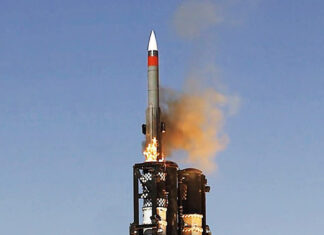AESA radars continue to capture the imagination and enthusiasm of designers and air forces, as their development progress and systems becoming more mature and reliable. While only a few systems actually work with full functionality on a regular basis, Active Electronic Scanning Array (AESA) provides virtually unlimited growth potential, due to its inherent agility (as a software controlled, electronically steering device), and design flexibility. Apart from its basic radar functionality, AESA can be used actively or passively, in support of a broad range of applications – including high power jamming, communications datalink or electronic intelligence (ELINT) sensor, passively employing its sensitive receive modules.
Communicating by Radar
Tapping the potential of non-traditional Intelligence Surveillance and Reconnaissance (ISR) Raytheon and L-3 Communications teamed to exploit data transfer applications of AESA radars. During flight tests conducted by the team, AESA radars were used to communicate high bandwidth SAR image map data at extremely high speed – far exceeding the capabilities of current fighter communication systems. Images were sent at a TV speed of 30 frames per second, from the aircraft to a ground based processing center. When image exploitation was completed, it was transmitted back to the aircraft, with the analyst’s annotations.
This capability demonstrates the potential uses of AESA radars with tactical and surveillance aircraft as well as unmanned systems. This new capability is poised to become a key element in the Global Information Grid (GIG), adding potential secure communication links that will increase the GIG’s information gathering and decision making utility for all users. As these radars proliferate among operational units and the transmit-receive infrastructure grows, these capabilities will support an increasing array of applications such as combat identification and homeland security, areas where communications interoperability and data fusion are essential.
Going Net Centric now!
The thrust for net-centricity and overarching control via datalinks has also some negative effects, as it overloads the limited electromagnetic spectrum resources, driving users into ever higher frequencies. One of the ultimate solutions is the use narrow-band laser communications, carrying broadband point-to-point communications between airborne or surface bound terminals and specially equipped satellite. (Laser communications between satellites is already in development). The advantages of laser communications are numerous – they are discrete, resistant to countermeasures, extremely difficult to intercept and are immune to conventional eavesdropping techniques. Since these links do not require frequency coordination, they can establish connection rapidly and can sustain high transfer rates (and operating at high data-rate (100 MB/sec – 1 GB/sec).
Live communications via the Laser Optical Link (LOLA) was demonstrated during the Paris Air Show by the French Ministry of Defense’ armament development and procurement agency (DGA). The exhibit was linked, via satellite, to an airborne Mystère 20 aircraft, transmitting live imagery captured on board. The display transferred live video from the cabin sending clear views of the countryside below. LOLA rapidly established links, within less than one second, and consistently transferred data at rates of 50 Mb/sec.
Advanced Integrated Intelligence, Surveillance, Target Acquisition and Reconnaissance (I-ISTAR) technologies, developed by Thales, highlighted an accelerated processing cycle of the Observation, Orientation, Decision and Action (OODA). Thales is developing the Aeros Recon NG recce pod as an airborne recce EO system for the French Rafale. The pod has already been qualified for the Mirage 2000 and will enter service with Rafale F3 by 2009 for the French Air Force and Navy. One of the new technologies demonstrated by Thales this year, is the “Imagery on Demand” (IOD) technology, enabling the dissemination of real-time optimized optical or SAR images over low-bandwidth battlefield communications. Such systems enable analysts and end users to share images processed by the Thales MINDS systems deployed in fixed or forward locations.
Non traditional ISR is becoming a popular element in the planning and support of joint operations. At the Paris Airshow DRS described now Advanced Fighter Aircraft Command and control system (AFACE) pod system could establish real-time, worldwide air-to-air and air-to-ground modular communications and intelligence sharing network. Current FACE pods, carried on standard missile launch rails by A-10s, F-15s, F-18 and CF-18s have accumulated over fifty thousand flight hours, offering faster response to time critical targets and significantly improving low altitude communications, since they reduce the aircraft dependency on UHF/VHF repeater towers. The advanced version will be available in pod, or internally mounted configurations, providing real-time flight tracking (via GPS and INS). It will include a flight data recorder providing mission planning and debriefing functions. AFACE will introduce more versatile communications including secure voice and data, video, support conference calls and pilot dial-out. It will also include broadband Iridium link and WiFi connection. The system is offered with two add-on modules, supporting non traditional ISR and counter IED missions. The geo-referenced targeting mission module will establish geo-referenced imagery database on board enabling users to download relevant images according to their preference. The system will also support ‘cursor on target’ functionality, extracting accurate target coordinates for geo-targeted weapons. For the Anti-IED (electronic attack) mission, the system could be used to augment other EW platforms covering high priority missions, rendering select ground threats ineffective.
The Russian Communications specialist Polyot unveiled some of the new capabilities, driving the evolving command and control infrastructure supporting modern Russian fighters, used domestically and for export. Polyot claims that aircraft supported by their encrypted, jam resistant datalinks can achieve up to 25% increase in combat effectiveness, by establishing autonomous fighter groups and reducing pilot workload. The systems support high speed data networks and use universal interfaces for integration, linking the aircraft avionics and ground based communications.
A more autonomous ‘pilot associate’ style system was introduced by Elbit Systems. Called “On-Board Decision Support and Mission Planning System – ODSS, this system is designed to arrange, process and display to the pilot, the most relevant mission critical information necessary for optimal flight path decision. Based on operational expertise, experience and input from combat pilots, Elbit Systems established the ODSS knowledge-base, employing artificial intelligence system to analyze current mission data, tactical and geographical information, generating a recommended flight path designed for each mission profile. For example, ODSS can recommend an optimal flight path which leaves optimal space for evasive maneuvers in a segment of the flight path exposed to enemy threats. The system is used on the ground, supporting an automated mission preparation. While airborne, ODSS contributes to faster, more accurate and efficient decisions, based on the rapid and continuous analysis of multiple possible options.
Precision Attack Getting Cheaper?
Few new weapons were on display here. Much of the work is being focused on reducing the ‘cost of precision kill’ by introducing affordable, high precision guidance systems, and lighter weapons both contributing to more precise effect with less collateral damage. To enhance future, low-cost guided weapons, low-cost strap-down dual-mode seekers employing Semi-Active Laser (SAL) and Infra-Red (IR) guidance systems are developed by MBDA. These components will be used with powerful, low-cost computing and actuating systems enhancing future ‘smart’ munitions, including 68/70mm guided rockets, 155mm guided artillery projectiles and 120mm mortar bombs.
Elbit Systems also unveiled a laser guidance kit developed for aerial weapons. In the past, the company developed laser guidance kits for the Wizzard guided bomb; these have now been miniaturized into guidance kits, fitting bombs as well as much smaller 68/70mm rockets, converting these into ‘metric’ precision-guided weapons. The kit, designated “STAR” improves the accuracy and overall effectiveness of attack missions as well as reducing collateral damage. The STAR guidance kit was recently selected by Boeing, to upgrade the JDAM GPS guided bombs.
Sagem displayed the growing family of AASM guided bombs, including 2,000, 1,000 and 500 pound weapons. Another version, a 250 pound guided bomb is currently in development. AASM is scheduled to enter service with the French Air Force Rafale squadrons this year (2007). Boeing recently received $28 million contract to fit laser guidance kits to 600 existing 500 pounds JDAMS (400 for the air force, 200 for the Navy) by 2009 to meet a quick reaction USAF program.
Fighting over GPS Control
GPS has become so common and natural, that we can’t think how we could live without it. But GPS is also highly sensitive to interference and deception, especially at war, when GPS jammers are employed. Such systems were shown by the Russian company Aviaconversiya, the same company that, in 2003, sold GPS jammers to Saddam Hussein. Aviaconversiya presented a range of portable / airborne and remotely controlled jammers called “Umbrella” that can cover a wire area disabling GPS services over the entire country. The employment of such systems will deny both friendly and enemy use of GPS guided systems, such as simple UAVs and GPS guided weapons (such as JDAM). “We don’t know how many systems were sold to Iraq, since they were procured by middlemen” Aviaconversiya executive told Defense Update, ‘but there were plenty of them. Until then, our biggest customer was the US government, buying our systems for evaluation and testing”. He added.
The Pentagon is certainly concerned about the vulnerability of its GPS systems. Several programs were launched to eliminate this capability gap. In particular, extensive work is in progress to improve the capability of the GPS guided Joint Direct Attack Munition (JDAM) to overcome GPS jamming. In June 2007 Boeing announced the successful completion of developmental flight testing of its integrated GPS Anti-Jam system (IGAS) for JDAM. According to Boeing’s program manager for IGAS, Dennis Kast, “IGAS uses digital signal processing to significantly reduce the impact of GPS jamming, allowing the warfighter to use the weapon with confidence in a variety of battlefield environments”. Boeing will complete the system’s development in 2007 and plans initial deliveries in 2008.
Another GPS counter-countermeasure, designed to protect GPS navigation systems against enemy jamming and deception was unveiled by Elisra, a member of the Elbit Systems group. The system went through successful flight trials exhibiting smooth and stable functioning. Throughout the test the system successfully annulled powerful jammers with its advanced spatial null steering technology, fully meeting the tests’ complex jamming challenge. The system, designated iSN/V1 ensures on-board GPS receivers are generating reliable, uninterrupted GPS solutions. The system covers extensive geographical areas, providing immunity for multiple satellite channels and handling multiple jammers operating on concurrent frequencies. It is designed for operation on board any system utilizing GPS, including aircraft, helicopters and UAVs.



















